

The 10 Stuff-Ups We All Make When Interpreting Research. Prevalence of Clinically and Empirically Defined Talents and Strengths in Autism - Online First. Most Autistic People Have Normal Brain Anatomy - Neuroskeptic. A new paper threatens to turn the world of autism neuroscience upside down.
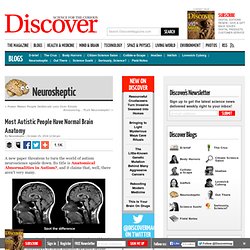
Its title is Anatomical Abnormalities in Autism? , and it claims that, well, there aren’t very many. Published in Cerebral Cortex by Israeli researchers Shlomi Haar and colleagues, the new research reports that there are virtually no differences in brain anatomy between people with autism and those without. What makes Haar et al.’s essentially negative claims so powerful is that their study had a huge sample size: they included structural MRI scans from 539 people diagnosed with high-functioning autism spectrum disorder (ASD) and 573 controls. This makes the paper an order of magnitude bigger than a typical structural MRI anatomy study in this field.
The scans came from the public Autism Brain Imaging Data Exchange (ABIDE) database, a data sharing initiative which pools scans from 18 different neuroimaging centers. Gettier and justified true belief: fifty years on. On the fiftieth anniversary of Gettier’s famous paper, Fred Dretske explains what we should have learned from it.
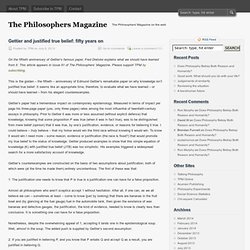
This article appears in Issue 61 of The Philosophers’ Magazine. Please support TPM by subscribing. Journal of Cognitive Neuroscience - Early Access. Eulerian Video Magnification. Banner slider Many seemingly static scenes contain subtle changes that are invisible to the naked human eye.
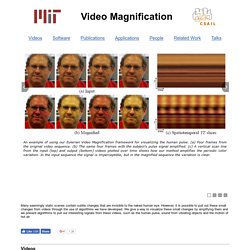
However, it is possible to pull out these small changes from videos through the use of algorithms we have developed. fMRI Evidence of ‘Mirror’ Responses to Geometric Shapes. Mirror neurons may be a genetic adaptation for social interaction [1].
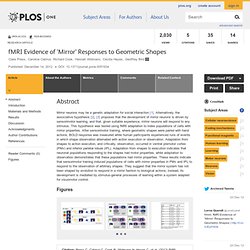
Alternatively, the associative hypothesis [2], [3] proposes that the development of mirror neurons is driven by sensorimotor learning, and that, given suitable experience, mirror neurons will respond to any stimulus. This hypothesis was tested using fMRI adaptation to index populations of cells with mirror properties. After sensorimotor training, where geometric shapes were paired with hand actions, BOLD response was measured while human participants experienced runs of events in which shape observation alternated with action execution or observation. "The mind is willing, but the flesh is weak": th... [Psychol Sci. 2012] University of Pittsburgh News « Tracing Knowledge … Στα ίχνη της Γνώσης. Research done at Pitt shows that decision-making memories are stored in a mysterious area of the brain known to be involved with vision and eye movements Aug 8, 2012 PITTSBURGH—The sought-after equanimity of “living in the moment” may be impossible, according to neuroscientists who’ve pinpointed a brain area responsible for using past decisions and outcomes to guide future behavior.

The study, based on research conducted at the University of Pittsburgh and published today in the professional journal Neuron, is the first of its kind to analyze signals associated with metacognition—a person’s ability to monitor and control cognition (a term cleverly described by researchers as “thinking about thinking.”) Smelling a skunk after a cold: Brain changes after a stuffed nose protect the sense of smell. Has a summer cold or mold allergy stuffed up your nose and dampened your sense of smell?
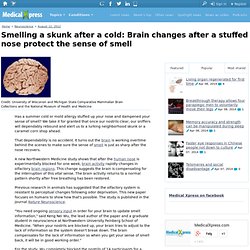
We take it for granted that once our nostrils clear, our sniffers will dependably rebound and alert us to a lurking neighborhood skunk or a caramel corn shop ahead. That dependability is no accident. It turns out the brain is working overtime behind the scenes to make sure the sense of smell is just as sharp after the nose recovers. A new Northwestern Medicine study shows that after the human nose is experimentally blocked for one week, brain activity rapidly changes in olfactory brain regions. Is the Map in Our Head Oriented North? + Author Affiliations Julia Frankenstein, Center for Cognitive Science, University of Freiburg, Friedrichstrasse 50, 79098 Freiburg, Germany E-mail: julia.frankenstein@cognition.uni-freiburg.de Tobias Meilinger, Max Planck Institute for Biological Cybernetics, Spemannstrasse 38, 72076 Tübingen, Germany E-mail: tobias.meilinger@tuebingen.mpg.de Abstract We examined how a highly familiar environmental space—one’s city of residence—is represented in memory.
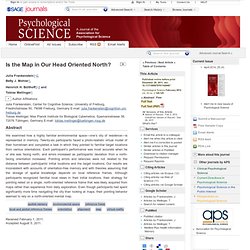
Twenty-six participants faced a photo-realistic virtual model of their hometown and completed a task in which they pointed to familiar target locations from various orientations. Zap your brain into the zone: Fast track to pure focus - life - 06 February 2012. I'm close to tears behind my thin cover of sandbags as 20 screaming, masked men run towards me at full speed, strapped into suicide bomb vests and clutching rifles.
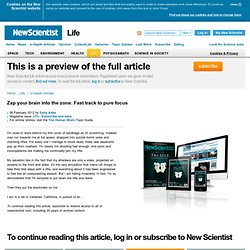
The man who hand-draws mathematical fractals. One of the subjects I work with, JP, has acquired synesthesia and acquired savant syndrome.
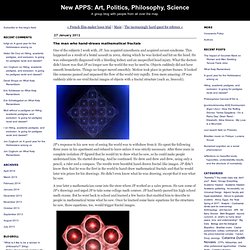
This happened as a result of a brutal assault in 2002, during which he was kicked and hit on the head. He was subsequently diagnosed with a bleeding kidney and an unspecified head injury. What the doctors didn't know was that JP no longer saw the world the way he used to. Objects suddenly did not have smooth boundaries. The Curse of Being Gifted? The statistical error that just keeps on coming. We all like to laugh at quacks when they misuse basic statistics. But what if academics, en masse, deploy errors that are equally foolish? This week Sander Nieuwenhuis and colleagues publish a mighty torpedo in the journal Nature Neuroscience. They've identified one direct, stark statistical error so widespread it appears in about half of all the published papers surveyed from the academic neuroscience research literature. Scientists probe connection between sight and touch in the brain.
Shakespeare famously referred to "the mind's eye," but scientists at USC now have also identified a "mind's touch.
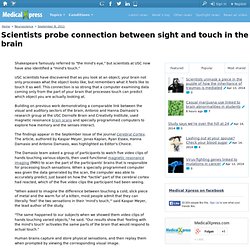
" USC scientists have discovered that as you look at an object, your brain not only processes what the object looks like, but remembers what it feels like to touch it as well. This connection is so strong that a computer examining data coming only from the part of your brain that processes touch can predict which object you are actually looking at. Building on previous work demonstrating a comparable link between the visual and auditory sectors of the brain, Antonio and Hanna Damasio's research group at the USC Dornsife Brain and Creativity Institute, used magnetic resonance brain scans and specially programmed computers to explore how memory and the senses interact. The findings appear in the September issue of the journal Cerebral Cortex. MIT Scientists Declare There Is No Science of Brains! In an article published yesterday in the Proceedings of the National Academy of Sciences ( ), scientists from the Kanwisher lab at MIT report finding regions of the brain that are specialized for language!
What, you aren't excited? Admittedly, this will not seem like news to the general public, despite the press release from MIT. In the popular imagination, local specialization--what we in the neurosciences call selectivity --is just how the brain works: this bit for vision, that bit for language, this one for motor control. So the paper reports exactly what we already know. Dog bites man. But in fact, a series of recent studies appearing in Behavioral and Brain Sciences , Journal of Cognitive Neuroscience , Nature Methods , Proceedings of the Cognitive Science Society , and Trends in Cognitive Science , among many other places, have painted a rather different picture.
The brain treats unwanted synapses like invading microbes. A microglial cell from the mouse brain expressing green fluorescent protein. Photograph: EMBL/ Rosa Paolicelli The human brain is an organ of staggering complexity, with hundreds of billions of neurons and glial cells forming something like a quadrillion connections, or synapses. Psychologists Use fMRI To Understand Ties Between Memories And The Imagination.
July 30, 2016 — An international team has devised a method for achieving 1 terapascal of static pressure - vastly higher than any previously ... read more July 29, 2016 — Scientists have tailored extremely small wires that carry light and electrons. These new structures could open up a potential path to smaller, lighter, or more efficient devices, they ... read more July 29, 2016 — Climate and energy scientists have developed a new method to pinpoint which electrical service areas will be most vulnerable as populations grow and temperatures ... read more Replication Project Investigates Self-Control as Limited Resource. The Power of Stories in Personality Psychology. The brain region that shouldn't be there. Medial wall of brain with posterior cingulate cortex. fMRI 4 Newbies. Guess: What Arguably Trivial Habit Gives a Giant Boost of Happiness? Is it... getting enough sleep ? Empirical Philosophy of Mind: A Productive Interaction of Science and Intuition.
Apps.bps.org.uk/_publicationfiles/consultation-responses/DSM-5 2011 - BPS response.pdf. Online Diagram Software and Flowchart Software - Gliffy. Fatty food cravings genetically programmed. (Medical Xpress) -- In a new study published in Neuropsychopharmacology, Dr. Why is a touch on the arm so persuasive? Even in fruit flies, enriched learning drives need for sleep. A neuropsychological perspective on procrastination. A recent study in the is the first to investigate subcomponents of self-reported executive function related to academic procrastination . New X-ray method for understanding brain disorders better. Researchers including members from the Niels Bohr Institute at the University of Copenhagen have developed a new method for making detailed X-ray images of brain cells.
The method, called SAXS-CT, can map the myelin sheaths of nerve cells, which are important for conditions such as multiple sclerosis and Alzheimer’s disease. The results have been published in the scientific journal, NeuroImage. Graduation as Gratitude. How the Internet is Revolutionizing Education - TNW Industry. When Less Information Is More: Why Vague Feedback Helps Weight Loss. Best of Our Blogs: May 13, 2011. Artificial grammar learning reveals inborn language sense, study shows.
Study reveals how taking an active role in learning enhances memory. Brain’s Visual Circuits do Error Correction on the Fly. New study shows humans are on auto pilot nearly half the time. Psychologist shows why we 'choke' under pressure. But why? A new computer model pinpoints the reasons. Does belief in free will lead to action? Deciphering hidden code reveals brain activity. Psychologists discover we've been underestimating the unconscious mind.